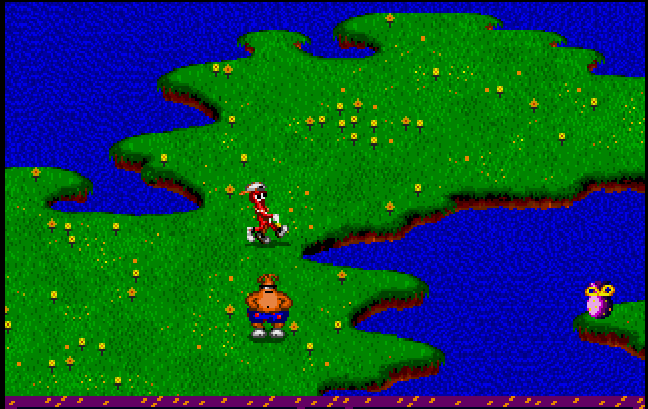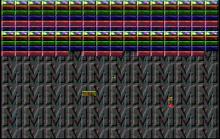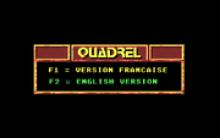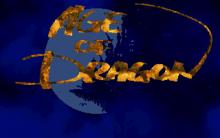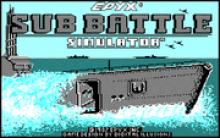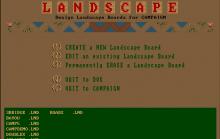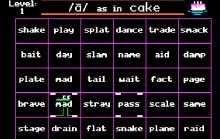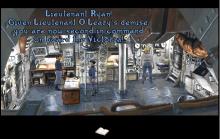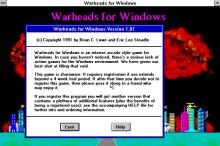ToeJam & Earl

How to play ToeJam & Earl
Each game uses different controls, Games can have combination of mouse,keyboard and Joystick.
ToeJam & Earl Description
ToeJam & Earl is an action video game created by Johnson Voorsanger Productions and published by Sega in 1991 for the Mega Drive. The game depicts two aliens, ToeJam and Earl, who have crash landed on Earth. The player guides them in their seach for pieces of their spacecraft's wreckage in order to escape. The gameplay comprises a treasure hunt inspired by role-playing computer game Rogue, with randomly generated levels and unidentified power-ups in the form of wrapped presents. The player must use these power-ups to succeed, while being careful not to open those with negative effects.
ToeJam & Earl arose from creator Greg Johnson's desire to combine a lighter version of Starflight's (a game he had previously worked on, released in 1986) science fiction themes with the mechanics of Rogue, a game he had been a fan of at university. Programmer Mark Voorsanger was the other main force behind the game, with John Baker providing the game's acclaimed music. The game's pitch was eagerly received by Sega's American division due to its innovative concept and potential to create new mascots.
The game was met with strong reviews, which especially praised its originality, humor, soundtrack and two-player cooperative play, though some questioned the game's slow pace. ToeJam & Earl despite initial poor sales became a sleeper hit with a cult following. Its protagonists together became one of Sega's mascots, spawning a spin-off mini-game (Ready, Aim, Tomatoes) and a sequel, ToeJam & Earl in Panic on Funkotron. A second sequel, ToeJam & Earl III: Mission to Earth was eventually released for Microsoft's Xbox in 2002. ToeJam & Earl in Panic on Funkatron garnered positive reviews and sales, but disappointed fans with its more generic design, while the second sequel received mixed reviews and was a commercial failure. Research has suggested ToeJam & Earl is the most popular game among fans of the series.
The game concerns ToeJam and Earl, a "three-legged red alien" and "fat orange alien", both of whom have crash landed on Earth. The player must guide them in their search for parts of their spacecraft's wreckage in order to escape to their home planet of "Funkotron", all the while avoiding antagonistic Earthlings. ToeJam wears a large gold medallion and backwards baseball cap, while Earl dons high-tops and oversized sunglasses, both outfits being "over-the-top appropriation" of 1990s urban culture. Also, the characters' speech features Californian slang. The game is set to a soundtrack which has been described both as "jazz-funk" and rap. The game has been viewed as a surreal, comic satire, and a "daringly misanthropic commentary on Earthly life".
Gameplay
The action takes place on floating islands (representing Earth) viewed from a top-down perspective. Each island is one layer above the last, connected by an elevator. On certain levels a piece of spacecraft wreckage can be found and the game is won by collecting all these pieces. Falling from the edge of an island will cause the player's character to plummet to the level below, thus forcing them to again find the elevator on that level. Blocking ToeJam and Earl's path to each elevator is a variety of "Earthlings": these antagonists include hula girls, giant hamsters, "rampaging packs of nerds", "phantom ice-cream trucks", Bogeymen, man-eating mailboxes and "gangs of tomato-hurling police-chickens". There is however a handful of helpful Earthlings. The action is "largely non-violent", as the protagonists can only attack antagonists with the aid of tomatoes, one of many temporary power-ups.
ToeJam & Earl's mechanics are inspired by Rogue and thus the game is at its core a Roguelike or dungeon-crawl game. The game's levels are randomly generated, as are power-ups which come in the form of wrapped presents. These power-ups include hi-top shoes (enabling the characters to run faster), rocket-skates (which give a near-uncontrollable speed boost), a decoy (which distracts enemies) and "Icarus wings" (which allow the characters to fly). The player does not know the contents of presents until they are opened; once done so however, the contents of all presents of that particular appearance will be known. Not all presents contain helpful power-ups, however: the contents of some are harmful including a present which causes the loss of a "life" and a "Randomizer" which revokes the player's knowledge of all presents and randomizes them all over again. Identification of presents' contents is thus central to the game. The more presents the player opens, the closer he gets to accidentally opening the "Randomizer"; this prevents the game from becoming easier as the player identifies more power-ups.
Also central to the game is its two-player cooperative mode. This utilizes a camera system (unique at the time of its release) which splits the screen in two when players wander apart, but uses a single screen when both characters are in the same vicinity. When one player opens a present while in the vicinity of the other, its content will affect both players. Playing the game with two players reveals additional dialogue and jokes between the characters, which are not heard in the single player game.
Development
ToeJam & Earl's creator Greg Johnson became a fan of Rogue, the main inspiration behind the game, while a university student. After leaving university, Johnson worked on Starflight, released by Electronic Arts (then a small publisher) in 1986 and subsequently several other games for the company. The concept for ToeJam & Earl arose from the desire for a lighter version of Starflight's science-fiction themes, combined with the gameplay concepts of Rogue. Johnson met programmer Mark Voorsanger through a mutual friend, while walking on Mount Tam. Johnson related the concept of ToeJam & Earl to a receptive Voorsanger and the two resolved to make the game together. They formed Johnson Voorsanger Productions soon after, with work on the game beginning in earnest after the completion of Starflight 2 for Electronic Arts.
The developers were granted a meeting with Sega of America (then a small company of some 20 employees, according to Johnson), as both had experience working on commercial video games. The duo used cards with drawings of terrain on them to demonstrate their idea for randomly generated levels. Sega marketing manager Hugh Bowen immediately warmed to the concept, as Sega were interested in innovative games and new mascots to compete with Nintendo. Sega, however, did not believe a two player split-screen mode possible due to hardware issues; nevertheless, Voorsanger succeeded in implementing the feature, which was central to the creators' vision. The small development team comprised "former collaborators of Johnson's", while John Baker composed the game's music. Steve Purcell has also stated he contributed character designs to the game.
Reception and legacy
The game was met with positive reviews, "almost unanimous critical acclaim" according to UGO. A contemporary review in Mean Machines noted that while the action was somewhat slow paced for the critics' liking, they appreciated the game's addictive appeal and numerous eccentric features. One of the reviewers predicted: "Not everyone will like it - it's not normal enough for mass appeal - but I think it's destined to become a massive cult classic". Entertainment Weekly praised the "absolutely hilarious" sound effects and music. Boys' Life called it "another hot game" for the Mega Drive, alongside Sonic the Hedgehog. A review published in both the Chicago Tribune and Rome News-Tribune likened ToeJam and Earl to "an outer-space, rap version of Abbott and Costello". The article gave a positive verdict, praising the soundtrack, graphics and action and calling it "the funniest game we've seen in a long time". Several months after the game's release, Mega placed it as the 13th best Mega Drive game in its All-Time Top 100 feature. The magazine praised the game's "superbly manic and zany action" and deemed it both "original and insane". Despite critical acclaim, initial sales of the game were poor, leading Sega to deem it a commercial failure. Sales gradually increased over time however, as the game built a cult following through word of mouth. Subsequent to the release of Sonic the Hedgehog, the Mega Drive experienced a sharp increase in sales over Christmas 1991 with ToeJam & Earl benefiting further. This "slow burn" success ultimately resulted in the game becoming a "cult hit".
ToeJam and Earl became "one of Sega's second tier mascots, alongside Sonic", and one of the Mega Drive's "key exclusive franchises". The due appeared in a spin-off light gun game, Ready, Aim, Tomatoes, developed by Johnson Voorsanger Productions as one of six mini-games to appear on a cartridge released with the Menacer light gun. The developer then began work on a sequel proper in early 1992 and spent three months building on the original concept by adding more terrain types and indoor areas. Sega however conferred that they did not "understand" or "get" the game, nor see how it could be marketed. Johnson and Voorsanger thus began developing a more generic platform game, a concept to which Sega had been more receptive. This sequel, ToeJam & Earl in Panic on Funkotron, was released in 1993 to considerable anticipation, positive reviews and commercial success. Fans of the original however were disappointed at the radical departure from the original concept to a more generic type of game. Sega's subsequent video game console, the Saturn, performed poorly in the North American market and thus the ToeJam & Earl franchise was neglected. A ToeJam & Earl game for the Nintendo 64 was cancelled, but a third instalment was eventually released for the Xbox in 2002. The game returned to the concepts of the original game, but generated mixed reviews and poor sales.
In 2006, ToeJam & Earl was re-released on the Nintendo Wii's Virtual Console. Official Nintendo Magazine felt the game's enjoyability had diminished over time, but praised its humor, invention and two-player mode, giving it an 85% overall score. GameSpot noted that the 1990s idioms used in the game felt dated, but the gameplay was still enjoyable by modern standards, again especially the two player mode. 1UP also praised the two-player co-operative mode, though it felt it was less enjoyable when played solo, as well as noting the graphics and sound were "oddly primitive". Despite this and the fact the reviewer found it difficult to pin down the exact reasons for the game's appeal, the online magazine considered it "one of the best games to hit VC to date". EuroGamer however gave the game a negative review, with only two stars out of five. The reviewer was bored by what he deemed overly slow gameplay and found little satisfaction in the game's aim of hunting for "random tat". IGN called the game's visuals a "mixed bag" and again complained about the slow-paced action, but praised its unpredictability and felt the game's sound design was "One thing you absolutely can't fault".
ToeJam & Earl has been deemed since it's release as a "wierd", "strange", and "thoroughly odd" game. Critics have difficulty in determining a genre category for the game, with action, platformer and Roguelike being suggested labels. While not as successful as some of the Mega Drive's other popular titles, ToeJam & Earl has been considered a "classic", and a "cult" game in particular. According to an IGN survey, it is the most favoured of all three games in the franchise with 65% of respondents citing it as their preference. Research by the games' developers, prior to the conception of the third game, also found that a majority of fans preferred ToeJam & Earl to its sequel.
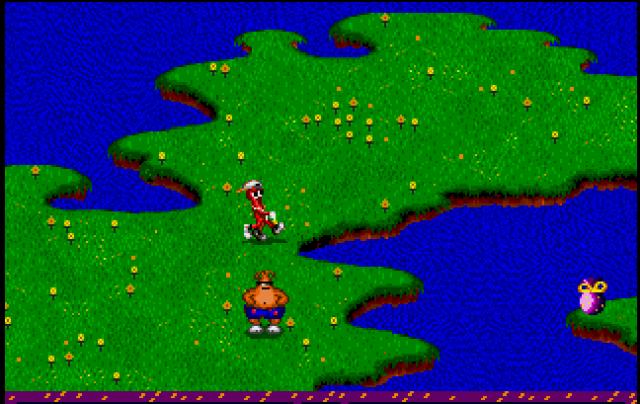
ToeJam & Earl - additional information







